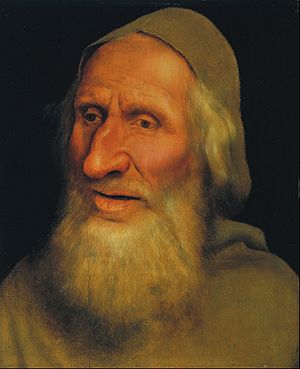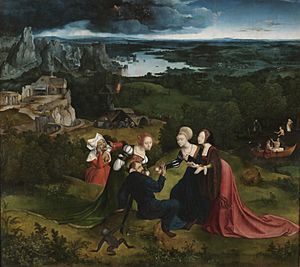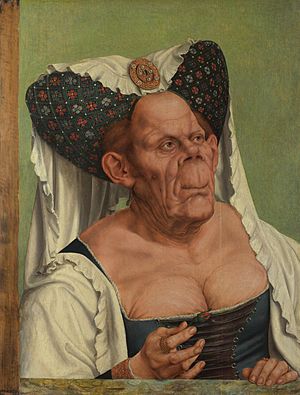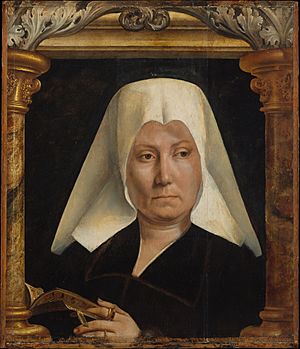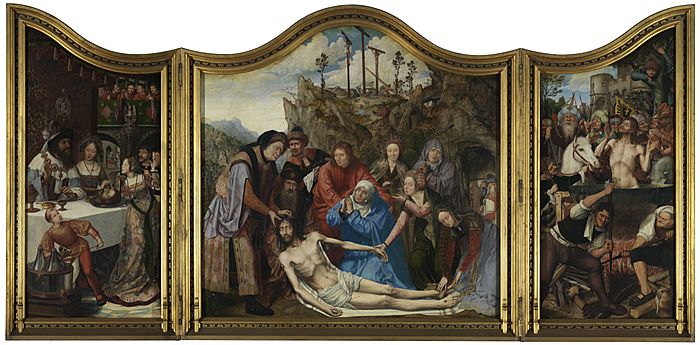Quentin Matsys facts for kids
Quick facts for kids
Quentin Matsys
|
|
|---|---|
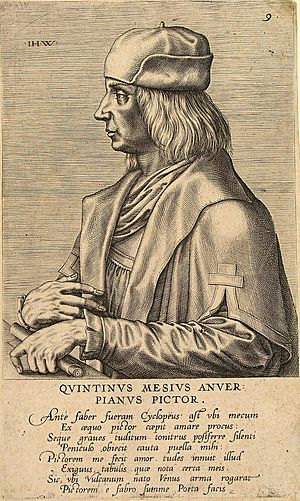
Quentin Matsys, engraved by Johannes Wierix with Dominicus Lampsonius' poem about how Matsys' girlfriend preferred the quiet paintbrush to the heavy noise of hammering
|
|
| Born | 1466 |
| Died | 1530 (aged 63–64) |
| Nationality | Flemish |
| Known for | Religious and satirical portraits |
|
Notable work
|
The Ugly Duchess |
| Movement | Antwerp School |
Quentin Matsys (Dutch: Quinten Matsijs) (1466–1530) was an important Flemish painter. He belonged to the Early Netherlandish art tradition. Matsys was born in Leuven, a city in what is now Belgium.
Some stories say he started his career as an ironsmith before becoming a painter. Matsys worked in Antwerp for over 20 years. He created many artworks that showed religious themes and sometimes had a funny, critical side. He is seen as the person who started the Antwerp school of painting. This school became very important in Flanders during the 1500s. Matsys brought new ideas and ways of painting, but he also respected older traditions.
Contents
A Young Artist's Beginnings
Most of what we know about Matsys' early life comes from old stories, not official records. People say he was born in Leuven to a family with a good income. He was one of four children.
One popular story says Matsys became a painter to impress a girl he liked. She thought painting was more romantic than being a blacksmith! However, another writer, Karel van Mander, said this wasn't true. He claimed Matsys became a painter because he was sick and too weak to work as a blacksmith. During his recovery, he started decorating prints for parties.
Matsys had four students during his time in Antwerp. It's also believed that another famous painter, Joachim Patinir, studied with Matsys. Patinir might have even helped Matsys with some of his landscape paintings. We don't have many records from this time, so it's not clear if Matsys traveled to Italy or other places for his training. However, his paintings show that he was influenced by artists from other countries.
Working in Leuven and Antwerp
In the 1400s, important painting centers in the Low Countries included Tournai, Bruges, Ghent, and Brussels. Leuven became more important later in the century. Then, in the early 1500s, Antwerp took the lead as the main art city.
We don't have guild records from Leuven before 1494. So, there's no official proof that Matsys became a master painter there. But most historians believe he got his early training in Leuven. He later joined Antwerp's Guild of Saint Luke, which was a group for artists. Matsys is considered one of the first important artists of this guild.
Matsys' Unique Painting Style
We don't know exactly how Matsys learned to paint. But his style shows influences from artists like Dirk Bouts, Hans Memling, and Rogier van der Weyden. When Matsys moved to Antwerp at age 25, his own style helped bring new life to Flemish art. He became a master in the Antwerp painters' guild in 1491.
Some of his most famous paintings show a funny, critical view of people and society. These include A Portrait of an Elderly Man (1513) and The Money Changer and His Wife (1514). He also painted religious artworks, like large altarpieces for churches. One of his most famous altarpieces was made for the Church of Saint Peter in Leuven.
Matsys' art often shows strong religious feelings, which was common in Flemish art. He also used a realistic style that sometimes made people look a bit strange or exaggerated. He paid close attention to small details, like jewelry and clothing.
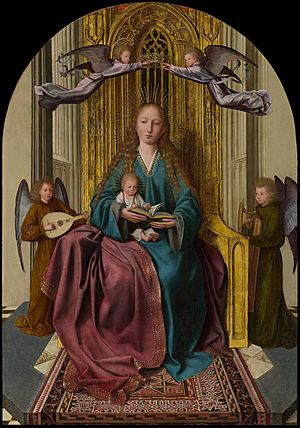
Oil on panel, 62.2 × 43.2 cm
National Gallery, London
Instead of focusing on the overall mood, Matsys often highlighted individual characters. He showed the calm beauty of saints and the rough expressions of guards or executioners. His paintings of bankers, like those in the Louvre and Windsor, sometimes show their greed. He also painted tender scenes, like his "Virgin and Child" paintings in Berlin and Amsterdam. His painting of Lucretia in Vienna shows deep sadness. The bright colors in his works made these exaggerated styles look appealing.
Matsys was also a very skilled portrait painter. His portrait of Ægidius (Peter Gilles) was so good that Thomas More wrote a poem praising it. He also painted a portrait of Maximilian of Austria. In his portraits, Matsys showed strong emotions and a very realistic style.
Artistic Influences
Matsys' style was different from other famous artists of his time, like Holbein and Dürer. He didn't focus as much on tiny, perfect details. However, he knew these masters. He likely met Holbein and Dürer even visited his home in Antwerp in 1520. Matsys also became the guardian of Joachim Patinir's children after Patinir died.
His paintings like Virgin and Christ, Ecce Homo, and Mater Dolorosa are known for their calm and powerful feeling. They became even more delicate as he grew older. It's thought that Matsys saw copies of Leonardo da Vinci's work. For example, his Madonna and Child with the Lamb was inspired by da Vinci's The Virgin and Child with St. Anne. This suggests that Matsys was influenced by Italian Renaissance artists and might have even traveled to Italy for a short time.
Later Life and Legacy
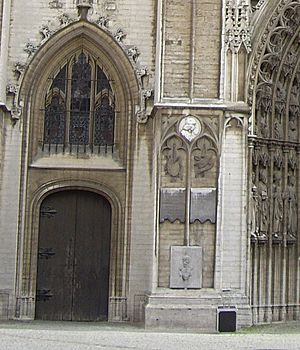
Quentin Matsys died in Antwerp in 1530. He was a very religious person. Sadly, some of his relatives were punished for their beliefs. His sister Catherine and her husband were executed in Leuven in 1543 for reading the Bible.
In 1629, a ceremony was held to mark 100 years since Matsys' death. A special plaque was put on the Antwerp Cathedral. It said: "in his time a smith and afterwards a famous painter." This kept alive the stories about Matsys' humble beginnings.
Matsys' most famous work is probably A Grotesque Old Woman. This painting inspired John Tenniel's drawing of the Duchess in Alice's Adventures in Wonderland. The painting might show a real person with a bone disease called Paget's disease. Some also say it's a symbolic portrait of Margaret, Countess of Tyrol, who was called Maultasch, meaning "ugly woman" because of her marriage scandals.
His two large altarpieces, The Holy Kinship (1507–1509) and The Entombment of the Lord (1508–1511), are also very well-known. They were made for the Church of Saint Peter in Leuven and show his strong religious feelings and detailed style.
Matsys also painted parts of an altarpiece for the Convento da Madre de Deus in Lisbon. This altar showed the Seven Sorrows of Mary. Parts of it are now in the Museu Nacional de Arte Antiga, and one part, Flight into Egypt, is in the Worcester Art Museum. His painting Christ as the Man of Sorrows is in the J. Paul Getty Museum in Los Angeles.
Quentin's son, Jan Matsys, also became a painter. However, he mostly copied his father's style instead of creating new ones. Another son, Cornelis Matsys, was also a painter. Jan's son, Quentin Metsys the Younger, was an artist for the English royal court. He painted the Sieve Portrait of Elizabeth I of England.
Near the front of the Cathedral of Our Lady in Antwerp, there is a special well made of wrought-iron. It's known as the "Matsys Well." People say that the painter himself made it when he was a blacksmith.
Matsys was a very admired artist in Antwerp during the 1600s. He was one of the founders of the local painting school, which later became very famous with artists like Peter Paul Rubens.
A story series by British author Pierce Egan the Younger called Quintin Matsys was published in 1839.
See also
 In Spanish: Quinten Massys para niños
In Spanish: Quinten Massys para niños
- Ill-Matched Marriage


